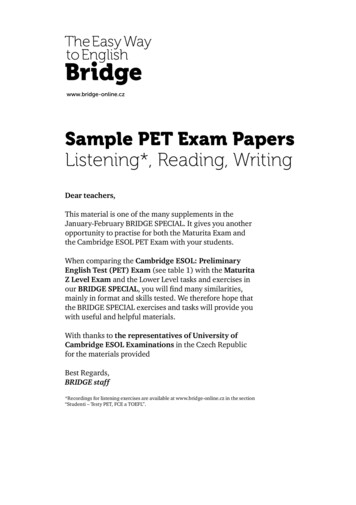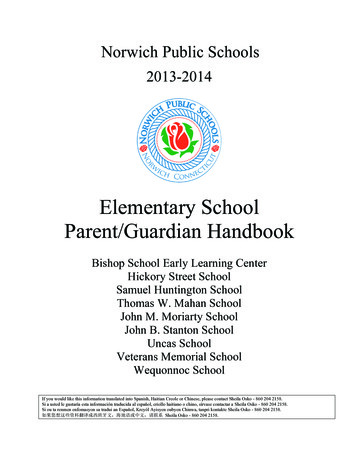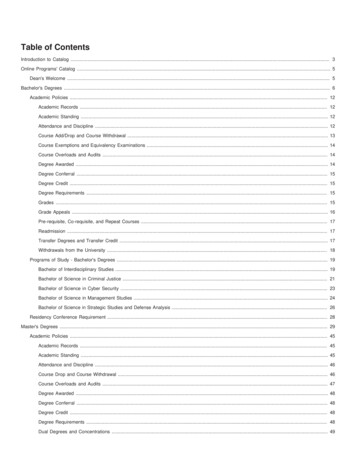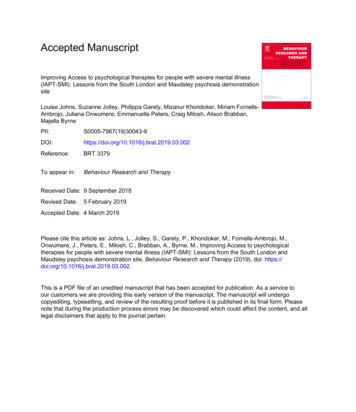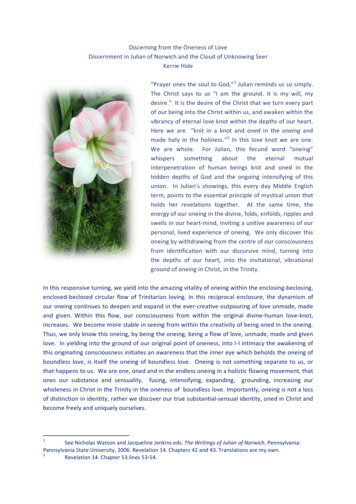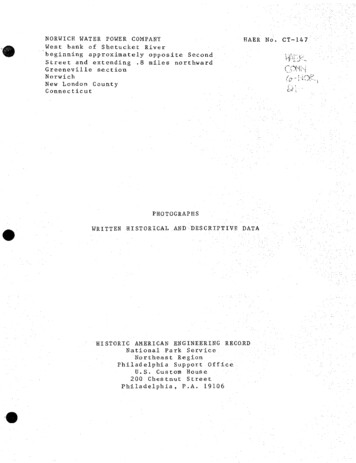
Transcription
NORWICH WATER POWER COMPANYWest bank of Shetucket Riverbeginning approximately opposite SecondStreet and extending .8 miles northwardGreeneville sectionNorwichNew London CountyConnecticutHAER No. CT-147PHOTOGRAPHSWRITTEN HISTORICAL AND DESCRIPTIVE DATAHISTORIC AMERICAN ENGINEERING RECORDNational Park ServiceNortheast RegionPhiladelphia Support OfficeU.S. Custom House200 Chestnut StreetPhiladelphia, P.A. 19106COHH
HISTORIC AMERICAN ENGINEERING RECORDNORWICH WATER POWER COMPANYLocation:HAER No. CT-147West bank of Shetucket River,beginning approximately opposite SecondStreet and extending .8 miles northwardGreeneville section, NorwichNew London County, ConnecticutUSGS Norwich QuadrangleUTM Coordinates:19.745610.4601620 {south end)19.745940.4603940 (north end)Date of Construction1829, 1882Engineer:James F. Baldwin (1829 dam and canal);Hiram Cook (1882 headgates and dam),Chandler & Palmer (c.1915 rebuilding)Contractor:Gaspar Webler (1829 dam and canal)Present Owner:City of Norwich, ConnecticutCity HallNorwich, Connecticut 06360Present Use:Hydroelectric power generationSignificance:The canal and dam of the Norwich WaterPower Company, incorporated in 1828,was one of the earliest water powerengineering projects in Connecticut.The company sold water power tomanufacturers who built mills on astrip of land between the canal and theriver. The village of Greeneville grewup around the canal's industrialactivity and remained one of Norwich'smost populous neighborhoods well intothe 20th century.Project Information:This documentation was undertaken in1994-1996 in accordance with aMemorandum of Agreement among theFederal Energy Regulatory Commission,the Connecticut State HistoricPreservation Office, and the AdvisoryCouncil on Historic Preservation. Thedam will be modified to accommodate afish passage.Bruce ClouetteHistoric Resource ConsultantsHartford, CT 06106
NORWICH WATER POWER COMPANYHAER No. CT-147(Page 2)DescriptionThe Norwich Water Power Company Dam and Canal includes a largetimber-crib and masonry dam and a headgate structure dating from1882, a long canal paralleling the Shetucket River on its westbank, a reinforced-concrete canal spillway built in the early20th century, and numerous historically related industrialbuildings clustered at the southern end of the canal. Inaddition, there are visible remains from the original episode ofconstruction in 1829-1832. The associated village ofGreeneville lies to the west of the canal and consists of a gridof streets filled with dozens of 19th-century worker tenementsand other dwellings, churches, and commercial buildings.The earliest portions of the resource are about 1,200 feetupstream from the present dam {known as the Greeneville Dam):they include stone abutments to the Norwich Water PowerCompany's original dam; the substructure of the originalheadgates, visible as stone piers with mortises in the sides forthe gates; foundations for a second headgate structure, added toincrease the intake capacity sometime after 1837; and more than1,000 feet of canal that was no longer needed after the facilitywas reconfigured in 1882. Reportedly, remains of the base ofthe original timber dam can be discerned at low water.The present dam dates from 1882 and appears as a planked timbercrib structure with sloping downstream face and wide two-stepapron. However, only the central portion of the 399'-longrollway, which runs straight across the river between masonryabutments, is entirely of timber-crib construction. Theremainder, at the two ends, contains portions of the originalrubble masonry structure behind a planked timber-crib downstreamface. The timber portions date from a rebuilding following adisastrous flood in 1886,- the upper portions of the crib, aswell as all of the apron and face planking, were completelyrebuilt in 1915. A course of granite coping, to whichflashboards can be secured to raise the level of water, runsalong the crest of the dam.The headgate structure, which also dates from 1882, provides sixgated arched intakes for the canal. The mechanisms that operatethe gates are sheltered by a board-sided gable-roofed gatehousestanding west of the dam's west abutment; the current gateoperating mechanisms were installed in 1918.The canal is about ten feet deep; it varies in width from about65 feet to 100 feet at the northern end and has a uniform widthof 65 feet as it passes through the industrial complexes at itssouthern end. The present banks of the canal are defined by
NORWICH WATER POWER COMPANYHAER No. CT-147(Page 3)vertical rubble masonry walls. At the northern end, areinforced-concrete spillway, built in 1923, sets an upper limitto the level of water in the canal.The canal was originally constructed with a trapezoidal crosssection between earth-berm banks and measured 45 feet wide atthe top and 18 feet wide at the bottom. Although the bulk ofthe canal was enlarged at the time of the construction of the1882 headgates and dam, its original size and character canstill be seen north of the dam, in the part bypassed in 1882.The water in the canal can be let out by a drain gate set in astone channel about 500 feet south of the headgates.The draingate is sheltered by a smaller version of the gatehouse and alsodates from 1882 .At the southern end of the canal are a number of multi-storybrick factory buildings on the east bank that formerly werepowered by the energy of water falling from the level of thecanal to the Shetucket River below (the canal provides a head ofabout 17 feet). The oldest building dates from c.1840, with themajority built around 1900. The factory complexes spill overonto the west bank of the canal and even across the tracks ofthe Providence and Worcester Railroad (originally the Norwichand Worcester), which parallels the canal a short distance tothe west. There formerly was at least one other large groupingof industrial buildings along the canal:the Hubbard paperfactory, dating from 1860 and destroyed by fire in the 20thcentury. Several other smaller industrial enterprises werefound here at one time or another and may be represented byarcheological remains. The City of Norwich's municipal electricutility operates a 1926 power station at the southern terminusof the canal, as well as a more modern hydroelectric facilityopposite Tenth Street.Historical Background and Technological SignificanceThe facility built by the Norwich Water Power Company is anexample of the diffusion of the model of speculative water powerdevelopment first brought to fruition in this country in Lowell,Massachusetts.Following the successful conversion of anavigation canal to manufacturing purposes at Lowell in 1823 byBoston merchants, entrepreneurs throughout New England attemptedto reproduce their results at other sites, even while Lowellitself underwent constant improvement with new dams, canals, andmanufacturing facilities. The Norwich site was the first suchdevelopment in Connecticut exclusively intended to provide
NORWICH WATER POWER COMPANYHAER No. CT-147(Page 4)manufacturing power,1 By damming a river that was probably toobig for any single entrepreneur to harness, the company createda waterpower that allowed several enterprises to becomeestablished and eventually grow into large industrial concerns.The associated village of Greeneville became home to many ofNorwich's residents and businesses, its fortunes rising andfalling with those of the factories along the canal.The idea for a dam on the Shetucket River in Norwich was thebrainchild of William P. Greene (1795-1864). Greene was from awell-to-do Boston family and practiced law in that cityfollowing his graduation from Harvard in 1814.In 1824 he movedto Norwich to pursue a career in commerce and manufacturing,joining William C. Gilman in the Thames Manufacturing Company,which produced cotton cloth at Yantic Falls. Two years later,he began his plan to build a dam and canal and sellmanufacturing sites to other entrepreneurs. He bought up landon both sides of the river from what became Greeneville to thenext falls to the north, where the Quinebaug River joins theShetucket. Greene then conveyed this property to the NorwichWater Power Company, which promptly set about building the damand canal. Greene went on to become one of Norwich's leadingcitizens, operating large textile enterprises both atGreeneville and Yantic Falls. He also was president of theThames Bank, one of the founders of the Quinebaug Bank and theNorwich and Worcester Railroad, an incorporator of the NorwichFree Academy, and mayor of the city in 1842.Greene was the largest shareholder in the company, but he wasjoined by many other members of Norwich's business andprofessional elite. Among the first stockholders were Dr. RalphFarnsworth, a medical practitioner,- prominent lawyers andpoliticians such as George L. Perkins, James Lanman, and CalvinGoddard, the latter two of whom were judges and former membersof Congress; merchants Jedediah Huntington, Daniel L. Coit,Arthur Gilman, and James Ripley; and manufacturers such asGreene's partner William C. Gilman, cotton mill owner CushingEells, and paper mill pioneers Amos and Russell Hubbard. TheHubbards, who ran what is said to have been the first Americanmade Foudrinier papermaking machine at Yantic Falls, moved theiroperations to Greeneville in i860, occupying a large site northof Eighth Street. Although the Enfield Canal (1827) was built primarily fornavigation, its proponents recognized its industrial potentialfrom the start, and in the 1830s several large industries werestarted along its banks.
NORWICH WATER POWER COMPANYHAER No. CT-147(Page 5)Just as Lowell initially made use of a navigation canal, so toothe Norwich Water Power Company was the direct descendant of theQuinebaug Canal, an abortive attempt to link Norwich, located atthe head of tidewater navigation, with inland westernMassachusetts.The canal never got further than surveying aroute along the Shetucket and Quinebaug Rivers.That survey,however, formed the basis for the engineering of the NorwichWater Power Company's facility, as well as for the eventualbuilding of the Norwich and Worcester Railroad.The engineer for both the Quinebaug Canal and the Norwich WaterPower Company project was James F. Baldwin (1782-1862).Baldwin was the son of the prominent engineer Loammi Baldwin,who had designed the Middlesex Canal, as well as the brother ofLoammi Baldwin, Jr., another well-known Boston civil engineer.James Baldwin in the 1820s became a major proponent of linkingBoston with western markets via a railroad, and himself surveyedthe route that later would become the Boston and Albany orWestern Railroad. Although he never achieved the stature of hisfather or brother, Baldwin collaborated on or was principallyresponsible for several major engineering works of theantebellum period, including the Boston and Lowell Railroad andthe Boston municipal water-supply reservoir at Lake Cochituate.Baldwin was aided in the Norwich project by the surveyor WilliamS. Prentice (b. 1798), whose name appears on the surveys ofmanufacturing sites that were made part of the original leasesin the 1830s. After working several years as a clerk in acountry store, Prentice attended Harvard but did not graduate.In the late 1820s he assisted Baldwin with the survey of thewestern railroad route in Massachusetts, and Baldwin's memorandabook makes clear that Prentice was left in charge of much of thesurveying at Norwich while Baldwin attended to other projectsunderway, which included water power developments in Grafton andBillerica, Massachusetts, and a new lock for the Enfield Canalin Suffield, Connecticut. Prentice eventually left the field ofengineering and moved in 1832 to LaGrange, Indiana, where hebecame a well-to-do farmer and community leader.There is no known prior direct link among Greene, Baldwin,Prentice, and the entrepreneurs who developed Lowell. However,both Baldwin and Greene pursued mercantile interests whileundertaking their careers as professional men in Boston andlikely became well-acquainted with the Lowell project.Moreover, Baldwin was the agent of the Middlesex Canal at thetime and in that capacity probably dealt with the Lowellmanufacturers concerning shipments of materials. Baldwin beganworking directly for the Lowell proprietors starting in 1830,while his Norwich project was still under construction, after
NORWICH WATER POWER COMPANYHAER No. CT-147(Page 6)Patrick T. Jackson hired him to lay out the route of the Bostonand Lowell Railroad.The contractor for the project was Gaspar Webler from the smallinland town of Columbia, Connecticut. Although the dam wasfinished on October 29, 1829, the canal took longer and wasincomplete even as the first leases for manufacturing sites wereexecuted in 1832. In the meantime, the Company leased outfishing rights to the water below the dam, which must haveteemed with shad, salmon, and other fish prevented fromcontinuing their usual movement upstream.In leasing out manufacturing sites, the company took care toprotect its investment. Brick or stone construction and slateroofs were mandated for all factory buildings. No chemicalworks, furnaces, powder works, or other dangerous uses wereallowed, and alcoholic spirits were forbidden on the premises.For an annual rent of 150 per mill power (equivalent to whatwould power a cotton mill of 4,000 spindles), the companyguaranteed it would provide the water and maintain the dam andcanal in good condition. Individual intakes, water wheels, andtailraces were the responsibility of the manufacturers.The company also established a series of streets in a gridpattern west of the canal and the projected route of the Norwichand Worcester Railroad and divided the blocks up into lots forsale. Several of the manufacturers bought property nearby theirmill privileges while other lots were sold to factory employees,merchants and speculators. The water power company acted asmortgage banker for many of the purchasers, financing theerection of stores, tenements, and other buildings in thevillage that was immediately named Greeneville in honor of thecanal's chief proponent.Writing in 1833, just a year after leasing began, local surveyorWilliam Lester described the activity at Greeneville andpredicted the village's future prosperity:Two or three years since a Dam was built by theNorwich Water Power Company across the Shetucket atthis place, which is calculated to afford sufficientpower to carry 40 or 50 thousand spindles, and abouthalf the amount of which have been sold and extensivemanufacturing establishments have been erected; twolarge cotton mills, a paper mill, a button mill, aflannel manufactory, and a carpet and rug manufactory,' which, for the great perfection attained, the latterestablishment deserves particular commendation. Thisvillage is laid out with streets intersecting each
NORWICH WATER POWER COMPANYHAER No. CT-147(Page 7)other at right angles, and bids fair, ere long, to bea populous and thriving place.2Not all the early enterprises prospered; the button shop, whichhad 35 women at work making bone buttons in 18323, apparentlyhad disappeared by 1837. However, the canal itself was asuccess. Among the first large factories to be built was theQuinebaug Company's cotton mill at the southern end of theproject; it was sold to Thames Manufacturing (Greene's company)before the building was finished. Thames Manufacturing Companyoperated successfully for a time but went bankrupt in the Panicof 1837; it was succeeded by the Shetucket Company, whichenlarged the cotton mills and ran well into the 20th century.The next important lessee was the Chelsea Manufacturing Company,a paper manufacturer which began in 1835 and expanded itsproduction until it occupied several interconnected multi-storybuildings.Another long-term lessee, established in 1840, wasthe Norwich Bleaching and Calendaring Company, a cloth finishingfirm later known as the Norwich Bleaching, Dyeing, and PrintingCompany. All three of these prospered and ranked among thecity's largest industries, each employing hundreds of people.Chelsea Manufacturing, for example, ran 19 papermaking machinesin 1870, with 200 men and 100 women making fine writing paper ata rate of 10 tons a day,* its plant was valued at 400,000. A360-hp steam engine supplemented the 400 hp produced by its fivewater wheels.Although not as large as Chelsea Manufacturing Company, theHubbard paper mill was a substantial establishment, with fiverag engines and two papermaking machines in operation in 1886.4Smaller enterprises known to have existed at one time or anotheralong the canal, for which there are now no easily discernibleremains, include a screw shop, machine shop, dye works, woodentype factory, and two commercial gristmills. The survey ofwater power conducted as part of the Tenth Census of 188 0estimated the total rated output of the factories' waterwheelsat some 1,600 to 1,700 horsepower, with many manufacturerssupplementing the water power with steam engines.2A Sketch of Norwich, Including Notes of a Survey(Norwich: J. Dunham, 1833), p. 5.3Louis McLane, Documents Relative to the Manufactures inthe United States. House Document No. 308, 22nd Congress, 1stSession.4Lockwood's Directory of the Paper and Stationery Trades,1886-87. p. 30.
NORWICH WATER POWER COMPANYHAER No. CT-147(Page 8)With the continued prosperity of the various enterprises alongthe canal, the village of Greeneville became one of Norwich'smost populous outlying areas. By the time of the Civil War thetwo blocks along North Main and High streets were densely builtbetween Second and Twelfth streets, with numerous additionalhouses scattered along Prospect and Pleasant streets.Greeneville was formally incorporated into the City of Norwich(a separate government for the built-up part of the town) in1874.Sometime between the survey of Greeneville in 1837 and thereconstruction project of 1882, the company raised height of thedam and doubled the intake capacity of the canal. The north endof the canal was widened and an additional set of headgates wasbuilt adjacent to first. The need for a reliable flow of waterwas probably becoming more acute as the various factoriesincreased their productive capacity. Moreover, some of theenterprises such as the paper manufacturers and the NorwichBleaching and Calendaring Company undoubtedly also made use ofindustrial processing water from the canal.A similar concern appears to have prompted the widening of thecanal and the building of a new dam and headgate structure in1882. Since the northern part of the embankment had not beenput to use, nothing was lost by relocating the dam downstream.In addition to greater capacity and improved flow, the projectresulted in greater pondage and reduced the problems (such asicing and seepage) associated with long canals.The engineer for the 1882 dam and headgates project was HiramCook (1827-1927) . Cook, who was also president of the NorwichWater Power Company at the time, had only a common-schooleducation and a little private tutoring. However, while workingas a school teacher, he studied engineering and surveying on hisown, and he was able to find work as an assistant engineerduring the construction of the New London Northern Railroad(1849). In 1860 he went to work for the Norwich and WorcesterRailroad, assuming responsibility in 1866 for the maintenance ofall their buildings, track, and bridges. He also had a privatepractice as a civil engineer, and around 1880 became presidentof the Norwich Water Power Company. Although he retired fromconsulting around 1890, he continued to advise the company andto perform whatever engineering was needed; in 1896 he resumedthe presidency. As late as 1915, he undertook the survey of thedam's structural integrity that resulted in its rebuilding thatyear.In the early 20th century, the timber portions of the dam werefound to be deteriorating and so the top seven or eight courses
NORWICH WATER POWER COMPANYHAER No. CT-147(Page 9)were replaced. The headgate operating mechanisms and the canaloverflow spillway were rebuilt shortly thereafter.The engineers for the facility's 20th-century improvements wereChandler and Palmer, Norwich's leading engineering firm of theperiod. Dating back to the first third of the 19th century, thefirm's modern history began in 1877, when Charles E. Chandlertook over the practice upon the retirement of Gen. William C.Stanton. Chandler (1852-1928) was educated at Woodstock Academyand learned engineering in the firm of Edgar Clark of Putnam.He served as City Engineer for Norwich for many years, duringwhich time he was responsible for numerous bridges, roads, andcomponents of the City's water system. His partner from 1897 onwas Shepard B. Palmer (1871-1945), an 1894 graduate of WorcesterPolytechnic Institute. Both men were members of the State Boardof Engineers, which had oversight over dam construction.Together Chandler and Palmer designed a majority of theengineering structures in the Norwich area in the late 19th andearly 20th centuries. Among their clients were all the majortextile manufacturers, the City Water Department, and local gas,street-railway, and electric utilities.The dam and canal are still in use, providing water to power thehydroelectric plants at its southern end and at Tenth Street.In anticipation of the latter, the dam, headgates, canal, andwater rights were purchased by the City of Norwich in 1961,which operates the property through its municipal power utility.
NORWICH WATER POWER COMPANYHAER No. CT-147{Page 10)BIBLIOGRAPHYManuscriptsBaldwin, James F. Memoranda book, 1829. Manuscript, BaldwinPapers, Baker Library, Harvard University, Boston,Massachusetts. Includes sketches of canal section andoriginal headgates.Chandler & Palmer. "Norwich Water Power Company Dam," permitapplication, December 1915, Connecticut State Board ofEngineers. Manuscript collection, Connecticut StateLibrary. File includes "Early History of the GreenevilleDam," drawings, and photographs of the 1915 reconstruction.Chandler & Palmer. "Plan of Gate House and Hoists, NorwichWater Power Co." Blueprint, 1918, files of Chandler,Palmer & King, Norwich.Chandler & Palmer. "Plan Showing New Concrete Core Wall, Weir,Piers, and Upper Apron at Canal Wasteway." Blueprint,1923, files of Chandler, Palmer & King, Norwich.Cunningham Associates. The Village of Greeneville: AnHistorical and Architectural Survey. Norwich HeritageTrust and Connecticut Historical Commission. 1991. Copyat Otis Library, Norwich.Norwich, City of. Public Utilities Department.Greeneville plants.Drawing files,Norwich Water Power Company. "Proposals by the Norwich WaterPower Company for the Sale of Their Water Power and Land."Norwich Land Records, Vol. 43, pp. 194ff (1832). Includessections of a manuscript survey by William S. Prentice,Esq. Account book. Manuscript, 1829, ConnecticutHistorical Society, Hartford. Not strictly companyaccounts, these transactions belong to a merchant (perhapsGreene himself) authorized to buy goods and hire labor onthe company's behalf. Most concern the building of the damin 1829.
NORWICH WATER POWER COMPANYHAER No. CT-147(Page 11)Maps and ViewsArt Work of Norwich.Norwich:George E. White Co., 1898.Bailey, 0. H. Bird's-Eye View of Norwich.& Co., 1876.Boston:0. H. BaileyBaldwin, James F. Survey of Norwich Water Power Company, 1829.Manuscript, Baldwin Papers, Clements Library, University ofMichigan, Ann Arbor.Beers, F. W. Atlas of New London County, Connecticut.York:Beers, Ellis & Soule, 1868.Chandler, Charles E. "Greeneville, 1884."Library, Norwich.NewBlueprint, OtisFairchild Aerial Survey. Aerial photograph, 1934.State Library, Hartford.ConnecticutLester, William, Jr. Map of New London and Windham Counties inConnecticut. New Haven, 1833. Although showing the canalcorrectly, the street grid of Greeneville is not quite toscale.A Plan of Greenville, Norwich, Connecticut. New York: P. A.Messier & Co., 1837. Photocopy of tracing, 1896, byCharles E. Chandler, Norwich City and Town Clerk, Norwich.Sanborn Map and Publishing Company.New York, 1926.Insurance Maps of Norwich.Walling, H. F. Map of New London County Connecticut.Philadelphia: William E. Baker, 1854.Published Sources"Baldwin, James F." National Cyclopedia of American Biography.New York:James T. White & Co., 1900. Vol. 10, p. 303.Baldwin, James F.Survey and Charter of the Ouinebaug Canal.Norwich, 1827.Binney, C. J. F. The History and Genealogy of the Prentice orPrentiss Family in New England. Boston: priv. pr., 1852,pp. 133-34.Boston Directory, 1823-1830.
NORWICH WATER POWER COMPANYHAER No. CT-147(Page 12)Caulkins, Frances M.Hartford, 1873.History of Norwich, Connecticut.Chandler, Charles E."Dams Approved by Henry T. Potter."Connecticut Society of Civil Engineers. Proceedings, 1910,pp. 72-96.Chandler, Charles E. Obituary.Connecticut Society of CivilEngineers Proceedings, 1928, pp. 144-45.Eno, Arthur L. Jr. (ed.).Cotton Was King: A History ofLowell, Massachusetts. Lowell: Lowell Historical Society,1976.Genealogical and Biographical Record of New London County:Chicago: J. H. Beers, 1900. Entries on William P. Greene,Hiram Cook.Gillespie, c. B. (comp.). Norwich, The Rose of New England.Souvenir Edition of the Norwich Evening Record. Norwich.Clewath & Pullen, 1894.Hunter, Louis. A History of Industrial Power in the UnitedStates. 1780-1930. Vol. I: Water Power.Charlottesville,Va.: University Press of Virginia, 1979.Hurd, D. Hamilton {comp.).History of New London County,Connecticut.Philadelphia: J. W. Lewis & Co., 1892.Kahn, Renee, et al. The Historic Mills of Norwich, Connecticut:Feasibility and Planning Study. Norwich: City of NorwichPlanning Department, 1992.Kirkland, Edward C. Men, Cities and Transportation: A Study inNew England History, 1820-1900. Cambridge, Mass:HarvardUniversity Press, 1948.Lester, William, Jr. A Sketch of Norwich,Survey.Norwich:J. Dunham, 1833.Including Notes of aNorwich Directory, 1865-1915.Palmer, Shepard B. Obituary. Connecticut Society of CivilEngineers Proceedings, 1946, p. 267.Roth, Matthew. Connecticut: An Inventory of Historic1Engineering and Industrial Sites. Washington, D.C., 1981.
NORWICH WATER POWER COMPANYHAER No. CT-147(Page 13)Trowbridge, W.P. (comp.). Reports on the Water-Power of theUnited States. Washington: Government Printing Office,1885.Wegmann, Edward. The Design and Construction of Dams.York:J. Wiley & Sons, 1899.New
NORWICH WATER POWER COMPANYHAER No. CT-147(Page 14)Remains.of 1829 dam and headgatesCanal (c.1830), abandoned 1882Headgates (1882) {HAER No. CT-147-B)-Present dam (1 882, 1 91 5) (HAER No. CT-147-A)—Canal spillway (HAER No. CT-147-C)Site of c.1835 paper, screw, machine shopsCanal drain gate (HAER No. CT-147-D)Site of Durfey gristmill (c. 18601-Powerhouse (1966)GreenvillSite of Hubbard paper mill (1860)Site of Norwich Bleaching (c.1860)Formerly Chelsea paper mills (c.1860)Formerly Shetucket cotton mill (1840)Site Plan T Powerhouse (1926)Providence & Worcester Railroad(Norwich & Worcester Railroad)
NORWICH WATER POWER COMPANYHAER No. CT-147(Page 15)* V ««*M*"* Wf%View of Greeneville, 0. H. Bailey, 1876
NORWICH WATER POWER COMPANYHAER NO. CT-147(Page 16)Norwich Bleaching and Calendaring Company mills, with canalin foreground, detail from 0. H. Bailey, 1876
NORWICH WATER POWER COMPANYHAER No. CT-147(Page 17)View of gatehouse and dam, Art Work of Norwich (1898)
disastrous flood in 1886,- the upper portions of the crib, as well as all of the apron and face planking, were completely rebuilt in 1915. A course of granite coping, to which flashboards can be secured to raise the level of water, runs along the crest of the dam. The headgate structure, which also dates from 1882, provides six

